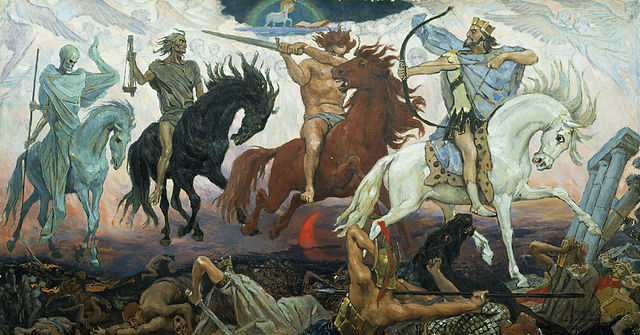 |
| Four Horsemen of Apocalypse, by Viktor Vasnetsov, 1887. |
New York, NY : G.P. Putnam's Sons, 2013.
457 p. ; 23 cm.
I loved Yancey's Monstrumologist and his wonderful follow-up, The Curse of the Wendigo - but his latest book, The 5th Wave wasn't as satisfying to me. The writing is really good, the plotting is interesting and engaging, and there is a lot of great action and thrills, but ,ultimately, for me there is just too much that strains credibility. What I liked about his previous two books was their specificity - a few characters involved in very circumscribed actions. The 5th Wave on the other hand involves the global (and I mean global) eradication of humanity by a super-advanced invasion force of aliens - but it just happens that a few characters who knew each other before the invasion not only survive the extermination, but successfully resist and sabotage it. I also just found the most important plot twist involving one of the main characters to be completely unbelievable. Either he would have never changed his behavior - or the aliens would have never been so stupid as to use such characters in their operations to rid the earth of humans.
But, these incredulities aside, there is a lot to enjoy in this novel. The waves of destruction (thus the title) by the aliens are frightening and exciting to the imagination: a massive EMP (electromagnetic pulse), induced tectonic upheaval creating worldwide megatsunamis, a very lethal viral pandemic, and sleeper human/alien killers, and... well, you get the picture.
Yancey also creates a strong and interesting female hero - something that is refreshingly more common these days (think Hunger Games, Slated and Divergent). In spite of not enjoying the book as much as I thought I might, I'd still give it high marks, and not hesitate recommending it to students looking for something exciting and interesting to read.
